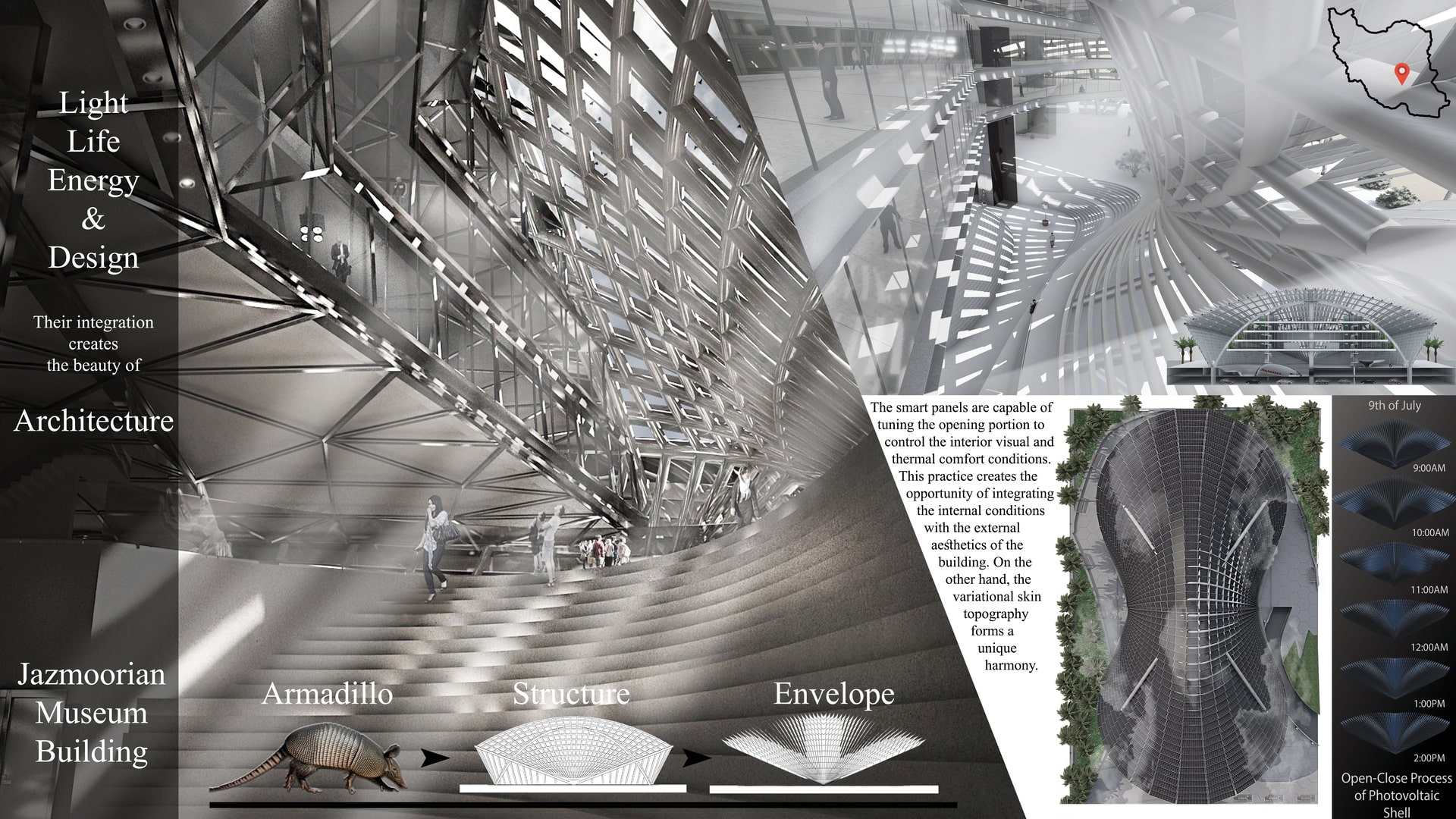Project Description
Jazmoorian is a small town located at the central hot and dry climate region of Iran. This museum building was aimed to be a monumental landmark for this region that can contribute the tourist attraction practices and evolution of the local economy. Therefore, the building has to be also a modern, yet a manifestation of the local culture, that can promote the indigenous practices and also bring the modernism to this traditional small town. The common traditional buildings in this region, typically consume a lot of energy to maintain the comfort conditions during the hot season. On the other hand, the sun position and its excessive light produce discomfort during a portion of days in hot season and hence, a smart technology is of great importance for a modern building in this region. The external skin of this museum building is composed of a curved cellular topography that is particularly designed to maximize the shading during hot seasons. On the other hand, each panel possesses a smart-grid-based control system that is linked to an integrated AI algorithm which measures and obtains data from weather forecasts, thermal and humidity sensors and adjusts the individual panel positions to maximize the internal comfort conditions. The internal comfort in divided into two main categories of visual and thermal comfort categories. For the fulfillment of the visual comfort criteria, the panels strive to allow the light passage in a certain portion that will fulfill the natural light demand and also avoid any glare situations. On the other hand, the thermal comfort parameters are based on maintaining the thermal comfort range with minimum active energy consumption by the HVAC system of the building. The main purpose of this project was to integrate the modern computer technologies such as AI and optimization algorithms with the cutting-edge mechanical actuation systems that will allow the construction of a cellular smart exterior skin for the building. The skin has been made cellular in order to enhance the controllability of it; because each individual panel is capable of varying its configuration based on its obtained data. In reality, the variation of the configuration of the panels will be smooth and form an outstanding external aesthetics for the building. The two main comfort categories, visual and thermal, will be considered inside the algorithms by their relative weighting multipliers. The algorithms can change their tendency towards either more visual or thermal comfort conditions, or simply choose a median and maintain both at a 50/50 condition. Overall, the panels will be active during the days and adapt the panel positions to enhance the interior comfort conditions. The typical time lag for the decision making is estimated to be 10-15 minutes, meaning that the panels can adapt themselves each 10-15 minutes; but for the reduction of energy consumption and also more stable conditions, the time-lag can be set to each 1 hour, resulting in a 5-10 times variation stage of the panels per day. Another main contribution of this project, is the integration of the main panel substrate structure with PV panels. In other words, each panel possesses a main semi-rectangular structure that has a PV panel mounted on top of it. This will contribute to the reduction of the active energy consumption of the panels, meaning that a large portion of the electrical energy demand for the movement of the actuators and running the smart-grid will be provided by the PV panels. This is feasible due to the fact that any panel that is casting any shadow and is active, is receiving a large portion of the sun light heat and hence can harvest this passive energy. As a final remark it can be stated that this project has strived to create a modern, yet cultural landmark for a small region, that can integrate the modernism with the cultural aspects of the region. In detail, numerous modern features such as advanced algorithms, mechanical actuators and PV panels are integrated with the regional demands of a typical building, and eventually has formed a unique shape for the building and its external skin. The visual aesthetics and internal comfort have been considered along the thermal comfort conditions, and a smart-grid system has been implemented in order to adapt the building skin with the real-time demands of the users. This practice will form a unique opportunity for the users to experience a comfortable and beautiful internal conditions and being provided by the proper natural lighting. The amount of this natural light is tuned by the smart system to provide enough natural light, and also prevent any glare or overheating situations. This is very crucial because the building’s region is hot and dry and therefore, a little amount of excessive sun light can instantaneously form a glare and overheating discomfort condition.
